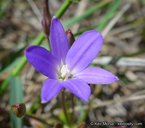Taxon Report
Brodiaea filifolia Wats.thread-leaved brodiaea |
 © 2016 Keir Morse |
Taxon Summary
Brodiaea filifolia, commonly known as thread-leaved brodiaea, is a perennial bulbiferous herb in the Themidaceae that is found only in California. It occurs within Chaparral (openings), Cismontane woodland, Coastal scrub, Playas, Valley and foothill grassland, and Vernal pools, growing at elevations from 25 to 1120 meters. Brodiaea filifolia is ranked 1B.1, Plants Rare, Threatened or Endangered in California and Elsewhere; Seriously threatened in California.Classification
|
Scientific Name: |
Brodiaea filifolia Wats. |
|
Common Name: |
thread-leaved brodiaea |
| Family: | Themidaceae |
| Element Code: | PMLIL0C050 |
| USDA Plants Symbol: | BRFI |
|
Synonyms/Other Names: |
|
Ecology and Life History
| Lifeform: | perennial bulbiferous herb |
| Blooming Period: Mar-Jun | Mar-Jun |
| Elevation: | 25-1120 (80-3675) |
| General Habitats: | Chaparral, Cismontane woodland, Coastal scrub, Playas, Valley and foothill grassland, Vernal pools |
| Microhabitat: | Clay (often) |
| Microhabitat Details: |
Conservation Status
| CA Rare Plant Rank: | 1B.1 |
| Global Rank: | G2 |
|
State Rank: |
S2 |
| State List: | CE |
| Fed List: | FT |
| Other Status: | SB_CalBG/RSABG; SB_CRES |
|
CRPR Changes: |
|
Occurrence Data from the CNDDB
| Total Occurrences: | 141 |
| Element Occurrence Ranks: | |
| Excellent (A) | 8 |
| Good (B) | 21 |
| Fair (C) | 22 |
| Poor (D) | 15 |
| None (X) | 12 |
| Unknown (U) | 63 |
| California Endemic: True | |
| California Counties and Islands: Name (Code) | |
| Los Angeles (LAX), Orange (ORA), Riverside (RIV), San Bernardino (SBD), San Diego (SDG) | |
| Quads: Name (Quad Code) | |
| Canada Gobernadora (3311755), El Toro (3311766), Encinitas (3311713), Escondido (3311711), Fallbrook (3311743), Glendora (3411727), Lake Elsinore (3311763), Lakeview (3311771), Las Pulgas Canyon (3311734), Margarita Peak (3311744), Morro Hill (3311733), Pala (3311731), Perris (3311772), Poway (3211781), Rancho Santa Fe (3311712), Romoland (3311762), San Bernardino North (3411723), San Clemente (3311745), San Juan Capistrano (3311756), San Luis Rey (3311723), San Marcos (3311722), San Pasqual (3311618), Sitton Peak (3311754), Wildomar (3311753), Winchester (3311761) | |
Threat List Data from the CNDDB
| Threat List Total: | 21 | |
| EOs with Threat Listed: | Total EOs | % of EOs |
| 72 | 51 % | |
| Development | 37 | 26% |
| Non-native plant impacts | 37 | 26% |
| Other | 17 | 12% |
| Road/trail construction/maint. | 12 | 8% |
| Vandalism/dumping/litter | 11 | 7% |
| Disking | 10 | 7% |
| Foot traffic/trampling | 7 | 4% |
| ORV activity | 7 | 4% |
| Recreational use (non-ORV) | 5 | 3% |
| Erosion/runoff | 5 | 3% |
| Agriculture | 4 | 2% |
| Grazing | 3 | 2% |
| Improper burning regime | 2 | 1% |
| Landfill | 2 | 1% |
| Military operations | 2 | 1% |
| Altered flood/tidal/hydrologic regime | 2 | 1% |
| Surface water diversion | 2 | 1% |
| Wood cutting or brush clearing | 2 | 1% |
| Waterway bank protection/maintenance | 1 | 0% |
| Dam/Inundation | 1 | 0% |
| Hybridization | 1 | 0% |
Notes
| Seriously threatened by residential development, agriculture, foot traffic, grazing, illegal dumping, non-native plants, and vehicles. Potentially threatened by road construction and fuel break maintenance. Hybridization with B. orcuttii and B. terrestris ssp. kernensis facilitated by European honeybees. See Proceedings of the American Academy of Arts and Sciences 17:381 (1882) for original description. |
|
Threats: |
|
Taxonomy: |
Citation
California Native Plant Society, Rare Plant Program. 2025. Rare Plant Inventory (online edition, v9.5.1). Website https://www.rareplants.cnps.org [accessed 11 December 2025].